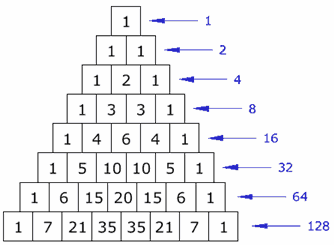
A term in the middle is the sum of two terms above it.
$\binom{n}{k}+\binom{n}{k+1}=\binom{n+1}{k}$

The sum of all elements in each row is $2^n$.
$\sum\limits_{k=0}^n \binom{n}{k}=2^n$
Binomial theorem
$\sum\limits_{k=0}^n \binom{n}{k} x^k=(1+x)^n$
Put $x=1$, then $\sum\limits_{k=0}^n \binom{n}{k}=2^n$.
Put $x=2$, then $\sum\limits_{k=0}^n 2^k \binom{n}{k}=3^n$.
Bijections
Given a set $X$ and a non-negative integer $r$, an r-subset of $X$ is a subset $A \subset X$ of cardinality $r$. We denote the set of r-subsets of $X$ by $P_r(X)$, namely, $P_r(X)=\{A \subset X|\: |A|=r\}$. Define the binomial coefficient to be the cardinality of the set $P_r(X)$ when $|X|=n$.
There is a bijection $P_r(X) \to P_{n-r}(X)$ given by mapping each subset to its complement $A \mapsto A^c$. Hence $\binom{n}{r}=\binom{n}{n-r}$.
[...]
Combinatorial arguments
Key idea: count the same quantity in two different ways
$n^2=(n-1)^2+2(n-1)+1$
We count the number of pairs $(i,j)$ where $1 \leq i,j \leq n$, which is $n^2$. We subdivide the pairs in regard to how many 1s they have. There are $(n-1)^2$ pairs with no 1s; $2(n-1)$ pairs with one 1s; 1 pair with two 1s. Hence the result. In the same vein, we have $n^3=(n-1)^3+3(n-1)^2+3(n-1)+1$.
Remark: We can use the same situation to prove another identity, $1+3+5+\cdots+(2n-1)=n^2$. We classify the pairs according to the value of $\text{max}(i,j)$. There is one pair $(1,1)$ with $\text{max}(i,j)=1$ and three pairs $(1,2), (2,1), (2,2)$ with $\text{max}(i,j)=2$. Similarly, there are five pairs when $\text{max}(i,j)=3$; seven pairs with max value $4$; $(2n-1)$ pairs with max value $n$.
$\binom{m+n}{2}=\binom{m}{2}+\binom{n}{2}+mn$
We count the number of ways of selecting two numbers from a set $S$ with $m+n$ elements. We partition $S$ into two subsets $A$ and $B$ with $m$ and $n$ elements respectively. Then, either both the two elements are from A or B, or there is one each from A and B. Hence the stated identity.
Stars and bars
The number of solutions to the equation $a_1+a_2+\cdots+a_n=k, a_i \geq 0, a_i \in \mathbb{N}$ is $\binom{k+n-1}{k}$.
Put differently, an n-set has $\binom{k+n-1}{k}$ multisets of size $k$.
The problem is the same as finding the number of ways of placing $k$ undistinguishable objects (denoted by $*$) in $n$ numbered boxes where $a_i$ represents the number of objects in box $i$. We now put $k$ objects in a row.
$******$
We use vertical bars $|$ to represent the boxes, meaning the separation between two consecutive boxes. Hence we need $n-1$ bars. For example, in the arrangement $**|***|*$, we have 3 boxes of which the first has 2 objects, the second has 3 objects and the last has 1 object.
In total there will be $k+n−1$ positions with stars or bars. Therefore, the number of solutions is $\binom{k+n-1}{k}$. [...]
Useful:
http://www.maths.qmul.ac.uk/~pjc/notes/comb.pdf
http://www.millersville.edu/~rumble/Math.310/pascal3.pdf
http://www.erp.sophia.ac.jp/Projects/ese/notes/rmm/lecture4.pdf
https://math.dartmouth.edu/~m68f13/lectec.pdf
No comments:
Post a Comment